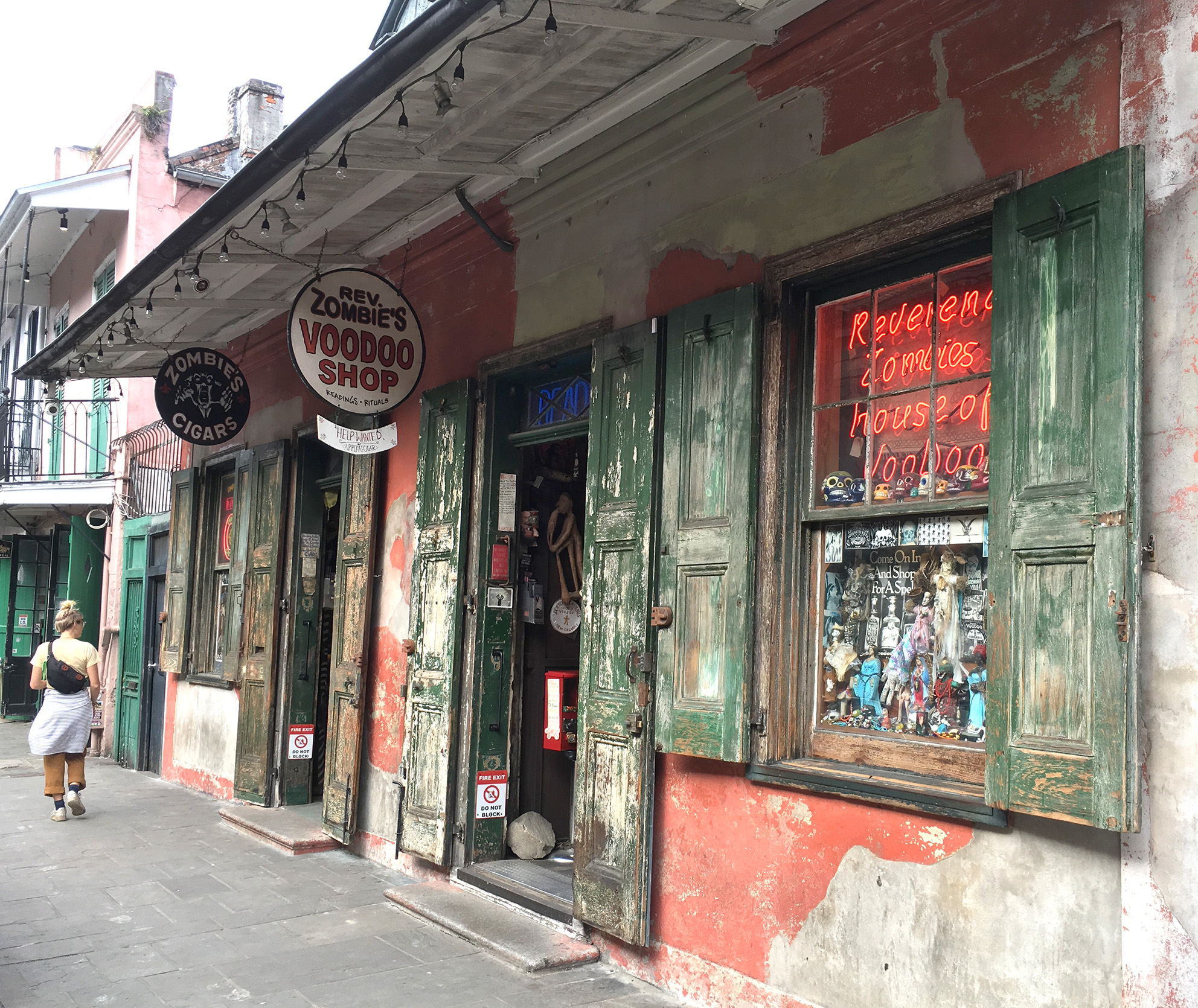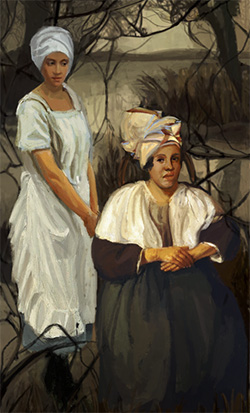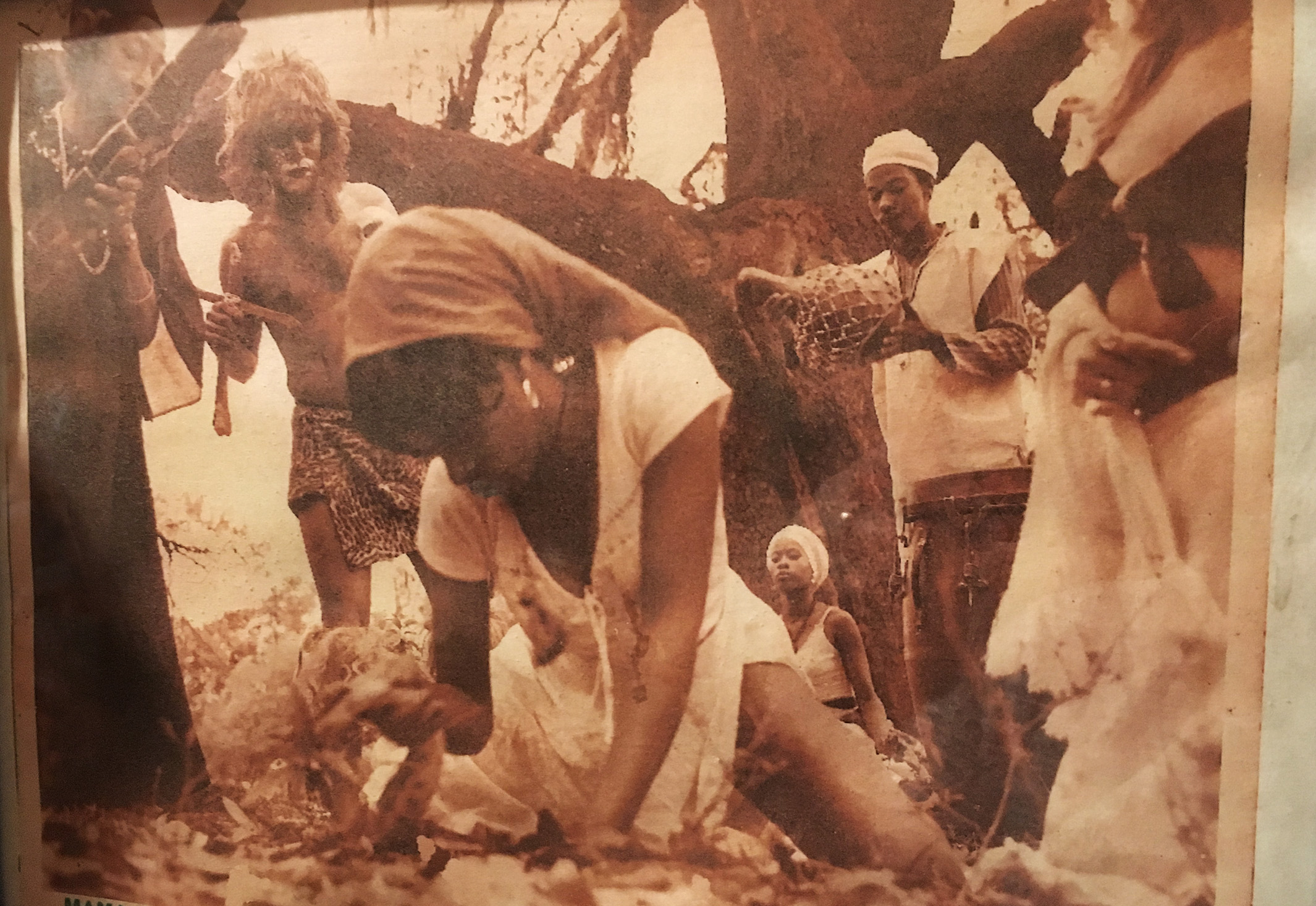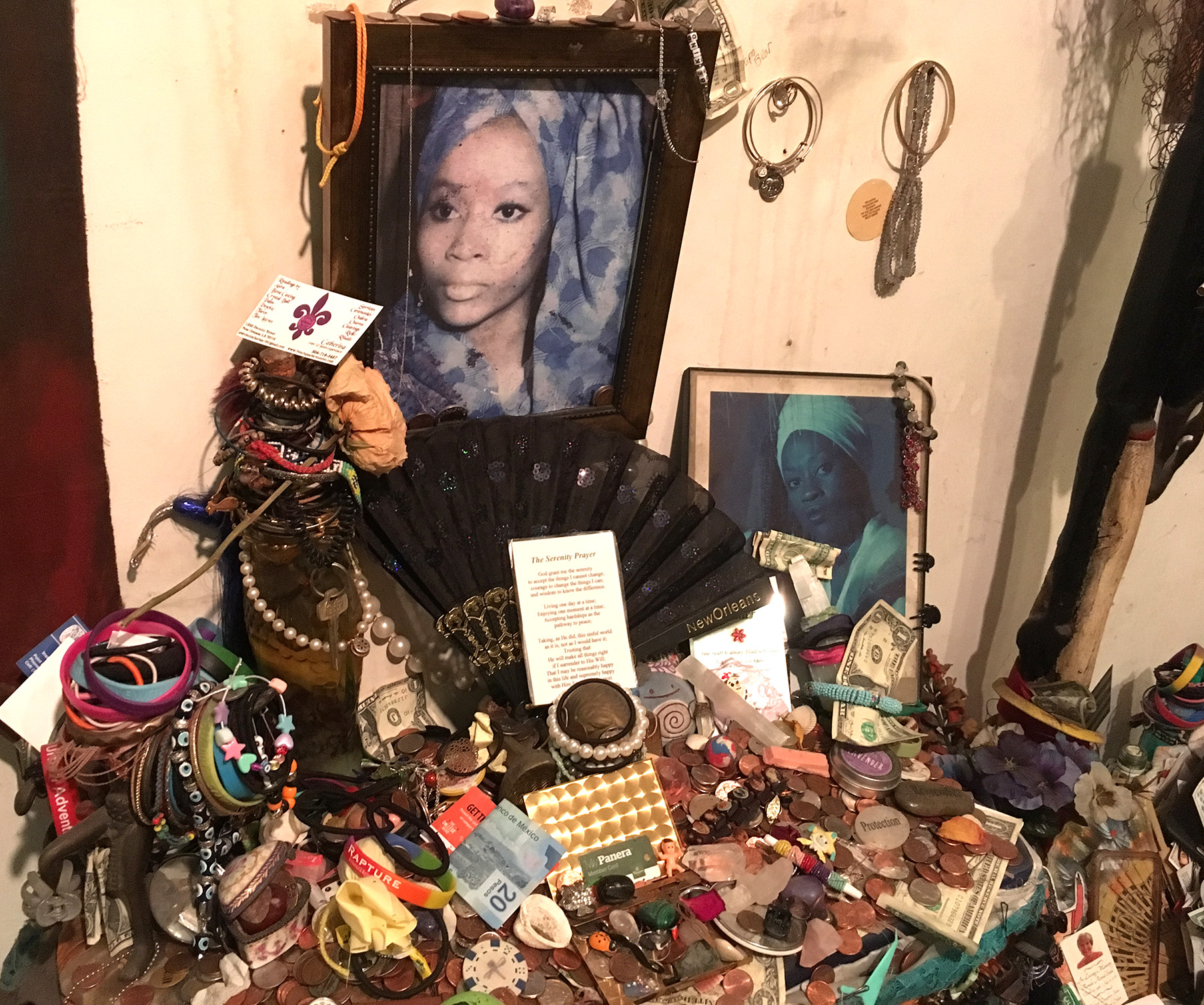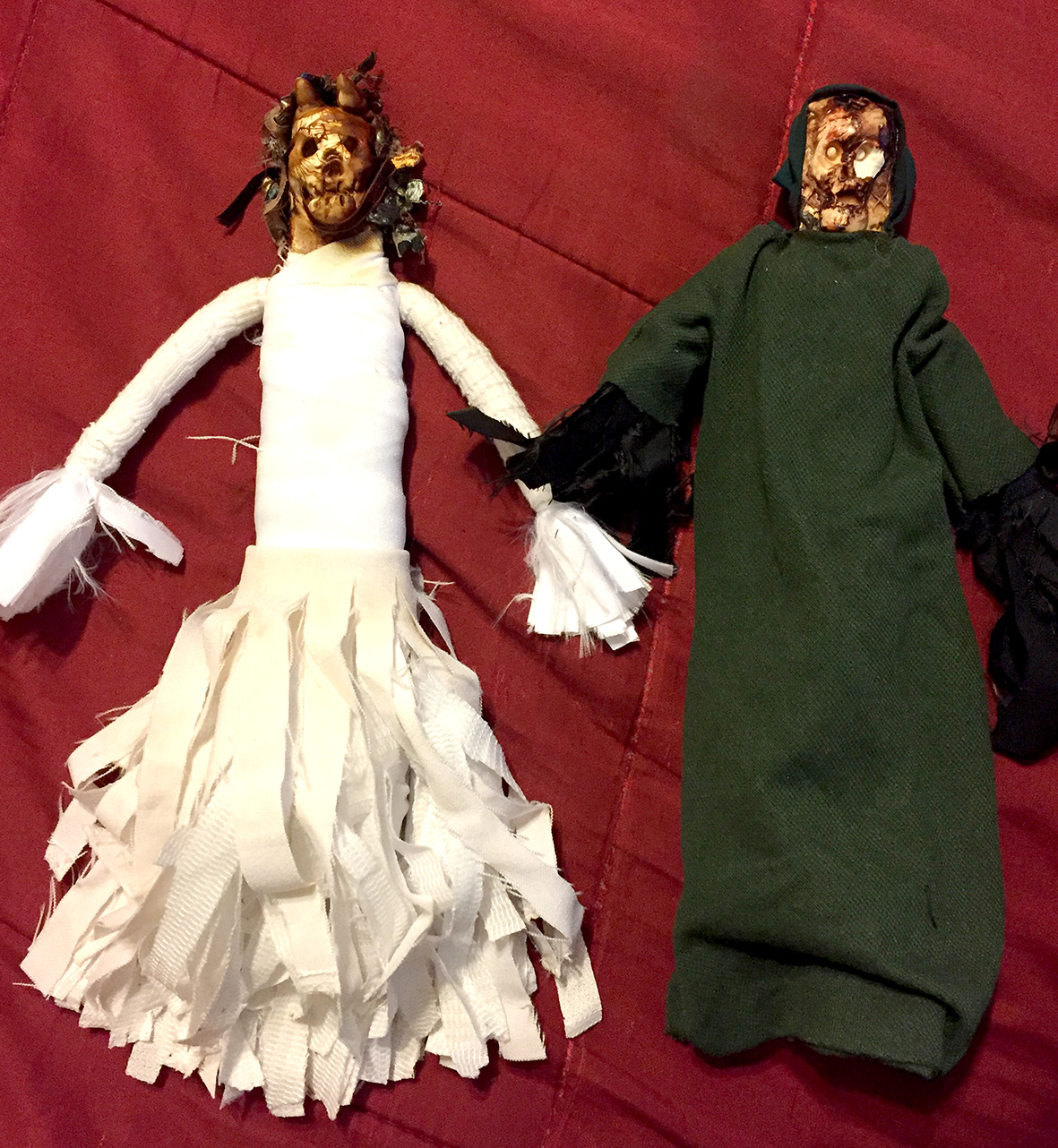Difference between revisions of "Voodoo"
Occultwiki (talk | contribs) |
Occultwiki (talk | contribs) |
||
| Line 1: | Line 1: | ||
[[File:Voodoo Shop.jpg|450px|thumb|Reverend Zombie's House of Voodoo Shop in New Orleans, Louisiana]] | [[File:Voodoo Shop.jpg|450px|thumb|Reverend Zombie's House of Voodoo Shop in New Orleans, Louisiana]] | ||
'''Louisiana Voodoo''', also known as '''New Orleans Voodoo''', is an [[African | '''Louisiana Voodoo''', also known as '''New Orleans Voodoo''', is an [[African diaspora religion]] which originated in Louisiana, now in the southern United States. It arose through a process of syncretism between the traditional religions of West Africa, the Roman Catholic form of [[Christianity]], and Haitian Vodou. No central authority is in control of Louisiana Voodoo, which is organized through autonomous groups. | ||
All of the West African groups contributed to the development of Louisiana Voodoo. Their knowledge of herbs, poisons, and the ritual creation of charms and [[amulet]]s, intended to protect oneself or harm others, became key elements of Louisiana Voodoo. | All of the West African groups contributed to the development of Louisiana Voodoo. Their knowledge of herbs, poisons, and the ritual creation of charms and [[amulet]]s, intended to protect oneself or harm others, became key elements of Louisiana Voodoo. | ||
| Line 17: | Line 17: | ||
From the early 18th century, enslaved West Africans—the majority of them Bambara and Kongo—were brought to the French colony of Louisiana. There, their traditional religions would have syncretized with the Roman Catholic beliefs of the French. This continued as Louisiana came under Spanish control and was then purchased by the United States in 1803. In the early 19th century, many migrants fleeing the Haitian Revolution arrived in Louisiana, bringing with them Haitian Vodou, which contributed to the formation of Louisiana Voodoo. | From the early 18th century, enslaved West Africans—the majority of them Bambara and Kongo—were brought to the French colony of Louisiana. There, their traditional religions would have syncretized with the Roman Catholic beliefs of the French. This continued as Louisiana came under Spanish control and was then purchased by the United States in 1803. In the early 19th century, many migrants fleeing the Haitian Revolution arrived in Louisiana, bringing with them Haitian Vodou, which contributed to the formation of Louisiana Voodoo. | ||
Although the religion was never banned, its practice was restricted through a range of laws regulating when and where black people could gather. Practiced secretly, it spread up the Mississippi River to Missouri. During the 19th century, several prominent practitioners, such as [[Marie Laveau]] and Doctor John, attracted considerable attention. By the early 20th century, the public practice of Voodoo had heavily declined. After the 1960s, the New Orleans tourist industry increasingly used references to Voodoo to attract visitors, while a Voodoo revival took place, the practitioners of which often drew heavily on other African | Although the religion was never banned, its practice was restricted through a range of laws regulating when and where black people could gather. Practiced secretly, it spread up the Mississippi River to Missouri. During the 19th century, several prominent practitioners, such as [[Marie Laveau]] and Doctor John, attracted considerable attention. By the early 20th century, the public practice of Voodoo had heavily declined. After the 1960s, the New Orleans tourist industry increasingly used references to Voodoo to attract visitors, while a Voodoo revival took place, the practitioners of which often drew heavily on other African diaspora religion such as Haitian Vodou and Cuban Santería. | ||
Louisiana Voodoo has not remained static, but has adapted and changed over time; in its original form, it probably survived into the early 20th century. In the late 20th century there was a revival of Louisiana Voodoo, creating a tradition that "more closely resembles" Haitian Vodou and Cuban Santería than the 19th-century Louisiana Voodoo that is described in historical accounts. Some 21st-century practitioners have also sought instruction from West African traditions, for instance, being initiated into West African Vodun. | Louisiana Voodoo has not remained static, but has adapted and changed over time; in its original form, it probably survived into the early 20th century. In the late 20th century there was a revival of Louisiana Voodoo, creating a tradition that "more closely resembles" Haitian Vodou and Cuban Santería than the 19th-century Louisiana Voodoo that is described in historical accounts. Some 21st-century practitioners have also sought instruction from West African traditions, for instance, being initiated into West African Vodun. | ||
| Line 40: | Line 40: | ||
In the 21st century, various Voodoo groups wear white clothing for their ceremonies. Influenced by Haitian Vodou, those assembled may dance around a central post, the poto mitan. Patterned flags, called drapos, may be brought out, while songs are sung in Haitian Kreyol. Drawings, called vèvè, may be made on the floor to invoke the spirits. Offerings will be given to the spirits. Contemporary Voodoo rites often entail calling spirits to enter the body of a practitioner, through which they can heal or confer blessings. The possessed individual will be called the "horse." | In the 21st century, various Voodoo groups wear white clothing for their ceremonies. Influenced by Haitian Vodou, those assembled may dance around a central post, the poto mitan. Patterned flags, called drapos, may be brought out, while songs are sung in Haitian Kreyol. Drawings, called vèvè, may be made on the floor to invoke the spirits. Offerings will be given to the spirits. Contemporary Voodoo rites often entail calling spirits to enter the body of a practitioner, through which they can heal or confer blessings. The possessed individual will be called the "horse." | ||
Practitioners sometimes performed rituals to deal with specific issues; in August 1995, Voodoo practitioners held a ritual in the Bywater area of New Orleans to try to drive away crack cocaine abuse, burglaries, prostitution, and assaults, while in 2001 the Voodoo priestess Ava Kay Jones performed a rite to drive harmful spirits away from the New Orleans Saints football team in the hope of improving their performance. | Practitioners sometimes performed rituals to deal with specific issues; in August 1995, Voodoo practitioners held a ritual in the Bywater area of New Orleans to try to drive away [[recreational drug|crack cocaine]] abuse, burglaries, prostitution, and assaults, while in 2001 the Voodoo priestess Ava Kay Jones performed a rite to drive harmful spirits away from the New Orleans Saints football team in the hope of improving their performance. | ||
==Altars== | ==Altars== | ||
Revision as of 05:53, 16 October 2024
Louisiana Voodoo, also known as New Orleans Voodoo, is an African diaspora religion which originated in Louisiana, now in the southern United States. It arose through a process of syncretism between the traditional religions of West Africa, the Roman Catholic form of Christianity, and Haitian Vodou. No central authority is in control of Louisiana Voodoo, which is organized through autonomous groups.
All of the West African groups contributed to the development of Louisiana Voodoo. Their knowledge of herbs, poisons, and the ritual creation of charms and amulets, intended to protect oneself or harm others, became key elements of Louisiana Voodoo.
The religion has long faced opposition from non-practitioners, who have characterized it as witchcraft and devil-worship, and many sensationalist portrayals of the religion have featured in popular culture.
Name
Several different spellings of Voodoo have been used; alternatives have included Voudou and Vaudou. The spelling Voodoo is sometimes used for the Louisiana practice to distinguish it from Haitian Vodou. In some sources, practitioners are referred to as "Voodoos" themselves, and elsewhere as "Voodooists."
A related term is hoodoo, which may originally have been largely synonymous with Voodoo. Over time, hoodoo came to describe "the brand of African American supernaturalism found along the Mississippi," entailing the use of charms and spells that made little reference to deities; in this it differs from the specific religion characterized by the term Voodoo.
Development
Voodoo is a largely oral tradition. It has no formal creed, no specific sacred text, and has no unifying organized structure or hierarchy. Practitioners will often adapt Voodoo to suit their specific requirements, in doing so often mixing it with other religious traditions. Throughout its history, many Voodoo practitioners have also practiced Roman Catholicism. While in the 21st century, Voodoo practitioners have for instance combined Voodoo with elements of Judaism and the Kabbalah, or with Hinduism.
From the early 18th century, enslaved West Africans—the majority of them Bambara and Kongo—were brought to the French colony of Louisiana. There, their traditional religions would have syncretized with the Roman Catholic beliefs of the French. This continued as Louisiana came under Spanish control and was then purchased by the United States in 1803. In the early 19th century, many migrants fleeing the Haitian Revolution arrived in Louisiana, bringing with them Haitian Vodou, which contributed to the formation of Louisiana Voodoo.
Although the religion was never banned, its practice was restricted through a range of laws regulating when and where black people could gather. Practiced secretly, it spread up the Mississippi River to Missouri. During the 19th century, several prominent practitioners, such as Marie Laveau and Doctor John, attracted considerable attention. By the early 20th century, the public practice of Voodoo had heavily declined. After the 1960s, the New Orleans tourist industry increasingly used references to Voodoo to attract visitors, while a Voodoo revival took place, the practitioners of which often drew heavily on other African diaspora religion such as Haitian Vodou and Cuban Santería.
Louisiana Voodoo has not remained static, but has adapted and changed over time; in its original form, it probably survived into the early 20th century. In the late 20th century there was a revival of Louisiana Voodoo, creating a tradition that "more closely resembles" Haitian Vodou and Cuban Santería than the 19th-century Louisiana Voodoo that is described in historical accounts. Some 21st-century practitioners have also sought instruction from West African traditions, for instance, being initiated into West African Vodun.
Historical accounts suggest that in the 19th century, the saints played a prominent role, although amid the 20th-century revival, the veneration of deities from other African diasporic religions became common.
Deities
Historical records reveal the names of various deities who were worshiped in Voodoo, prominent among them were Blanc Dani, the Grand Zombi, and Papa Lébat. These were venerated at altars, where sacrifices were made to them. Spirits of the dead also played a prominent role in historical Voodoo, with some contemporary practitioners regarding the religion as a form of ancestor worship.
Louisiana Voodoo also displayed a range of lesser deities, the names of which were recorded in various 19th-century sources. One of the chief deities was Blanc Dani, also known as Monsieur Danny, Voodoo Magnian, and Grandfather Rattlesnake. He was depicted as a serpent and associated with discord and the defeat of enemies. Another recorded name, Dambarra Soutons, may be an additional name for Blanc Dani. It is also possible that Blanc Dani was ultimately equated with another deity, known as the Grand Zombi, whose name meant "Great God" or "Great Spirit;" the term Zombi derives from the Kongo Bantu term nzambi (god). Another prominent deity was Papa Lébat, also called Liba, LaBas, or Laba Limba, and he was seen as a trickster as well as a doorkeeper; he is the only one of these New Orleans deities with an unequivocally Yoruba origin.
Monsieur Assonquer, also known as Onzancaire and On Sa Tier, was associated with good fortune, while Monsieur Agoussou or Vert Agoussou was associated with love. Vériquité was a spirit associated with the causing of illness, while Monsieur d'Embarass was linked to death. Charlo was a child deity. The names of several other deities are recorded, but with little known about their associations, including Jean Macouloumba, who was also known as Colomba; Maman You; and Yon Sue. There was also a deity called Samunga, called upon by practitioners in Missouri when they were collecting mud.
The Voodoo revival of the late 20th century has drawn many of its deities from Haitian Vodou, where these divinities are called lwa. Among the lwa commonly venerated are Oshun, Ezili la Flambo, Erzuli Freda, Ogo, Mara, and Legba. These can be divided into separate nanchon (nations), such as the Rada and the Petwo. Glassman's New Orleans temple for instance has separate altars to the Rada and Petwo lwa. Each of these is associated with particular items, colors, numbers, foodstuff, and drinks. They are often considered to be intermediaries of God, who in Haitian Vodou is usually termed Le Bon Dieu.
Practices
There are four phases to a Voodoo ritual, all identifiable by the song being sung: preparation, invocation, possession, and farewell. The songs are used to open the gate between the deities and the human world and invite the spirits to possess someone. The rituals of Louisiana Voodoo are based on African traditions that have absorbed various Christian, and especially Roman Catholic, influences. Reflecting this Roman Catholic influence, some recorded ceremonies have for instance begun with the recitation of the Apostles Creed and prayers to the Virgin Mary.
It has been claimed that St John's Eve (23 June) has particular significance in Louisiana Voodoo, with big celebrations on this date has taken place on the shores of Lake Pontchartrain during the 19th century. Some 21st-century Voodoo congregations continue to celebrate on St John's Eve; others, such as Osbey, reject the idea that St John's Eve is important in Louisiana Voodoo. Various contemporary practitioners celebrate All Saints Day (1 November) which they, following Haitian Vodou, link with the lwa Gede.
In the 21st century, various Voodoo groups wear white clothing for their ceremonies. Influenced by Haitian Vodou, those assembled may dance around a central post, the poto mitan. Patterned flags, called drapos, may be brought out, while songs are sung in Haitian Kreyol. Drawings, called vèvè, may be made on the floor to invoke the spirits. Offerings will be given to the spirits. Contemporary Voodoo rites often entail calling spirits to enter the body of a practitioner, through which they can heal or confer blessings. The possessed individual will be called the "horse."
Practitioners sometimes performed rituals to deal with specific issues; in August 1995, Voodoo practitioners held a ritual in the Bywater area of New Orleans to try to drive away crack cocaine abuse, burglaries, prostitution, and assaults, while in 2001 the Voodoo priestess Ava Kay Jones performed a rite to drive harmful spirits away from the New Orleans Saints football team in the hope of improving their performance.
Altars
Historical records describe the altars created by famous 19th-century Voodoo priestess Marie Laveau in her home and these descriptions resemble those of altars used in Haitian Vodou. Many contemporary practitioners have their own personal altars, often located in the kitchen or living room. These altars are understood as assisting communication with ancestors, with food and drink being offered to the ancestors at them.
Sacrifice was a recurring element of Louisiana Voodoo as it was historically practiced, as it continues to be in Haitian Vodou. Some 21st-century practitioners of Louisiana Voodoo do sacrifice animals in their rites, subsequently cooking and eating the carcass. It is nevertheless not a universal practice in Louisiana Voodoo; Glassman's group prohibits animal sacrifice in its rites. Although there is little proof that human sacrifice took place in Louisiana Voodoo, persistent rumors claimed that white children were being abducted and killed during some of its rites.
Many historical Voodoo rituals involved the presence of a snake; Marie Laveau was for instance described as communing with a snake during her ceremonies. This practice largely died out by the end of the 19th century, although some Voodoo revivalists have incorporated snake dances into their practices. In the 21st century, the New Orleans Voodoo Spiritual Temple has had its own "temple snake."
Gris-Gris
Charms, created to either harm or help, are called gris-gris. A common charm for protection or luck would consist of material wrapped up in red flannel and worn around the neck.
One example of a Voodoo curse was to place an object inside the pillow of the victim. Another involves placing a coffin (sometimes a small model; sometimes much larger) inscribed with the victim's name on their doorstep. In other instances, Voodoo practitioners sought to hex others by placing black crosses, salt, or mixtures incorporating mustard, lizards, bones, oil, and grave dust on a victim's doorstep. To counter these hexes, some people cleaned their doorstep or sprinkled it with powdered brick.
Despite its name, the idea of the "Voodoo doll" has little to do with either Louisiana Voodoo or Haitian Vodou; it derives from the European tradition of poppets. It is possible that the act of inserting pins into a human-shaped doll to cause harm was erroneously linked to African-derived traditions due to a misunderstanding of the nkisi nkondi of Bakongo religion.
Healing plays a prominent role in 21st century Louisiana Voodoo. Various shops, called botanicas, exist in New Orleans to sell herbs and other material for use in these preparations.
Animal sacrifice
Animal sacrifice is a traditional practice in Africa. It is done as an offering to the spirits, and also to ask a spirit to provide protection, healing, and other requests. When Africans were enslaved in the United States the practice continued in Voodoo and Hoodoo. The animals that are sacrificed are chickens. In West Africa among the Yoruba, blood sacrifices are left for Eshu-Elegba at the crossroads. The crossroads is a spiritual doorway to the spiritual realm where Eshu-Elegba resides. This practice was brought to the United States during the transatlantic slave trade, and African Americans into the twentieth century performed animal blood sacrifices at the crossroads. Eshu-Elegba became the crossroads spirit or the man of the crossroads in Voodoo.
Animal sacrifice has become a rare practice in the African American community. However, animal sacrifice was documented well into the late nineteenth century and into mid-twentieth century. For example, animal sacrifices are sometimes done at the crossroads as an offering to the crossroad spirit and to ask the spirit or spirits for a request.
